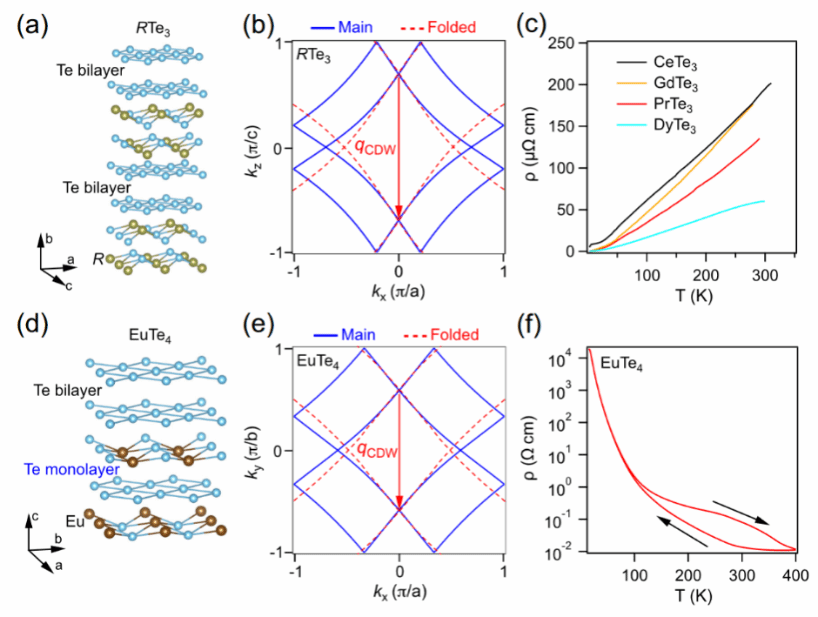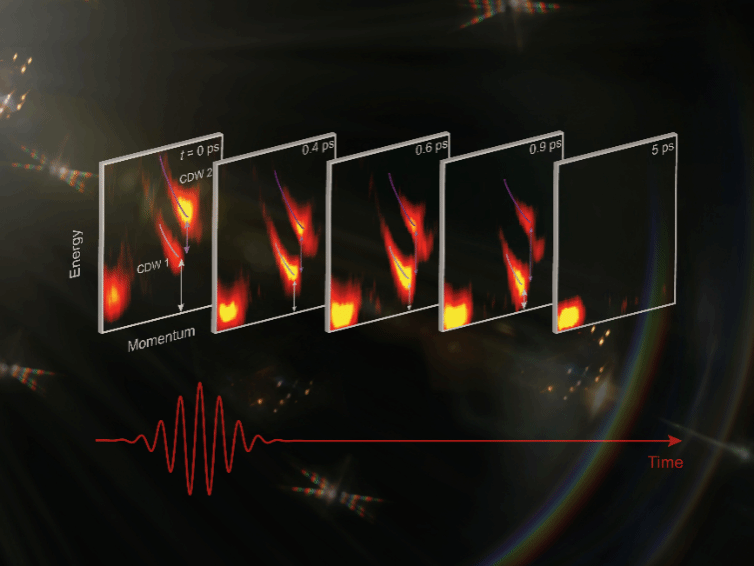搜索


Coexisting orders represent a key feature of strongly correlated materials, giving rise to numerous fascinating phenomena ranging from unconventional superconductivity to topological order. Unraveling the microscopic mechanisms and interactions underlying macroscopic coexistence phenomena remains a major challenge in condensed matter physics. In solid-state materials, ordered states arising from symmetry breaking are often accompanied by the emergence of energy gaps near the Fermi level, with gap widths proportional to the amplitude of the order parameter. A classic example is the charge density wave (CDW). Historically, in one-dimensional chain systems, Fermi surface nesting was considered the primary cause of CDW ordering, leading to a transition from a metallic to a semiconducting state. However, in quasi-two-dimensional materials, the complex Fermi surface structure often makes perfect nesting difficult to achieve, and the CDW gap typically does not open uniformly across the Fermi surface. Consequently, even in the CDW state, the system remains metallic. Recent studies reveal that both the RTe₃ system (where R represents lanthanide elements excluding Pm, Eu, Yb, and Lu) and EuTe₄ are quasi-two-dimensional CDW materials, with the CDW originating from the Te lattice. Surprisingly, despite sharing similar partially nested Fermi surface structures, their electrical transport properties exhibit significant differences. As shown in Figure 1, RTe₃ exhibits metallic behavior, whereas EuTe₄ displays anomalous semiconductor transport properties accompanied by a substantial thermal hysteresis effect [1-2], attracting extensive attention from researchers [3-7].

Figure 1 Comparison of Crystal Structures, Electronic Structures, and Transport Properties of RTe₃ and EuTe₄
Recently, a collaborative team including Associate Professor Lü Baiqing from the Li Zhengdao Institute, School of Physics and Astronomy at Shanghai Jiao Tong University and the Zhangjiang Advanced Research Institute; Professor Nuh Gedik from the Massachusetts Institute of Technology; Researcher Alfred Zong from the University of California, Berkeley; Professor Wang Nanlin from Peking University, and others. Using time-resolved angle-resolved photoemission spectroscopy (Tr-ARPES) with time-energy-momentum resolution, they successfully observed experimental evidence of semiconductor behavior in EuTe4 arising from the coexistence and interaction of two charge density waves (CDWs). The study revealed distinct CDWs in single-layer and double-layer Te structures, each corresponding to different energy gaps. Following optical excitation, the single-layer and double-layer CDWs exhibited divergent evolutionary behaviors. As shown in Figure 2, the larger double-layer CDW gap demonstrated reduced renormalization and faster recovery. More intriguingly, even within the monolayer CDW, energy gaps at different momentum spaces exhibit disproportionate renormalization, deviating from the isotropic dynamic evolution characteristic of a single order parameter. Through comparative analysis with DFT calculations, the researchers found that this deviation and the anomalous semiconductor behavior in the CDW state are closely related to the coupling interactions between monolayer and bilayer CDWs.

Figure 2: Dynamic evolution of single-layer and double-layer CDWs under optical excitation in EuTe4
This work not only provides a microscopic explanation for the correlated ground state and interaction mechanism under the coexistence of two CDWs in EuTe4, but also offers a highly effective research approach for studying the coexistence of ordered states and ultrafast laser manipulation in other quasi-two-dimensional systems. The findings were recently published in Physical Review Letters 132, 206401 (2024). Associate Professor Lü Baiqing and Researcher Alfred Zong are co-first authors, with Professor Nuh Gedik as corresponding author. Collaborators include Professor Wu Dong from the Beijing Academy of Quantum Information Sciences and Professor Wang Nanlin from the Center for Quantum Materials Science at Peking University. This work received support from the Ministry of Science and Technology, the National Natural Science Foundation of China, and the Shanghai Municipal Government.
Paper link:
https://journals.aps.org/prl/abstract/10.1103/PhysRevLett.132.206401
References:
[1]. D. Wu, Q. M. Liu, S. L. Chen, G. Y. Zhong, J. Su, L. Y. Shi, L. Tong, G. Xu, P. Gao, and N. L. Wang, Layered semiconductor EuTe₄ with charge density wave order in square tellurium sheets, Phys. Rev. Mater. 3, 024002 (2019).
[2]. B. Q. Lv et al., Unconventional hysteretic transition in a charge density wave, Phys. Rev. Lett. 128, 036401 (2022).
[3]. A. Pathak, M. K. Gupta, R. Mittal, and D. Bansal, Orbital- and atom-dependent linear dispersion across the Fermi level induces charge density wave instability in EuTe₄, Phys. Rev. B 105, 035120 (2022).
[4]. Q. Q. Zhang et al., Thermal hysteretic behavior and negative magnetoresistance in the charge density wave material EuTe₄, Phys. Rev. B 107, 115141 (2023).
[5]. C. Zhang et al., Angle-resolved photoemission spectroscopy study of charge density wave order in the layered semiconductor EuTe₄, Phys. Rev. B 106, L201108 (2022).
[6]. R. Rathore, A. Pathak, M. K. Gupta, R. Mittal, R. Kulkarni, A. Thamizhavel, H. Singhal, A. H. Said, and D. Bansal, Evolution of static charge density wave order, amplitude mode dynamics, and suppression of Kohn anomalies at the hysteretic transition in EuTe4, Phys. Rev. B 107, 024101 (2023).
[7]. Q. M. Liu et al., Room temperature nonvolatile optical control of polar order in a charge density wave, arXiv: 2310.102939 (2023).
Author:
Lü Baiqing Team
Contributing Institution:
Center for Ultrafast Science






 Address:No.1308 Keyuan Road, Pudong District, Shanghai
Address:No.1308 Keyuan Road, Pudong District, Shanghai Phone:86-21-54740000
Phone:86-21-54740000 E-mail:zias@sjtu.edu.cn
E-mail:zias@sjtu.edu.cn